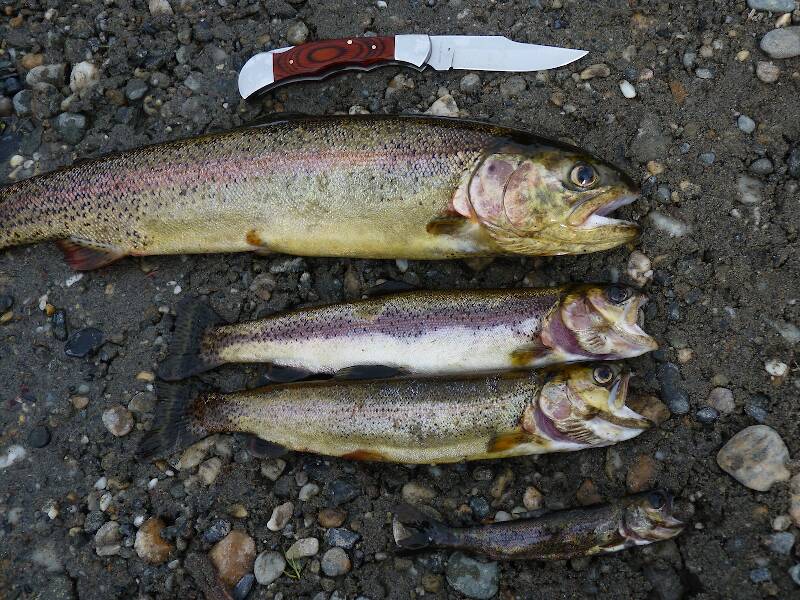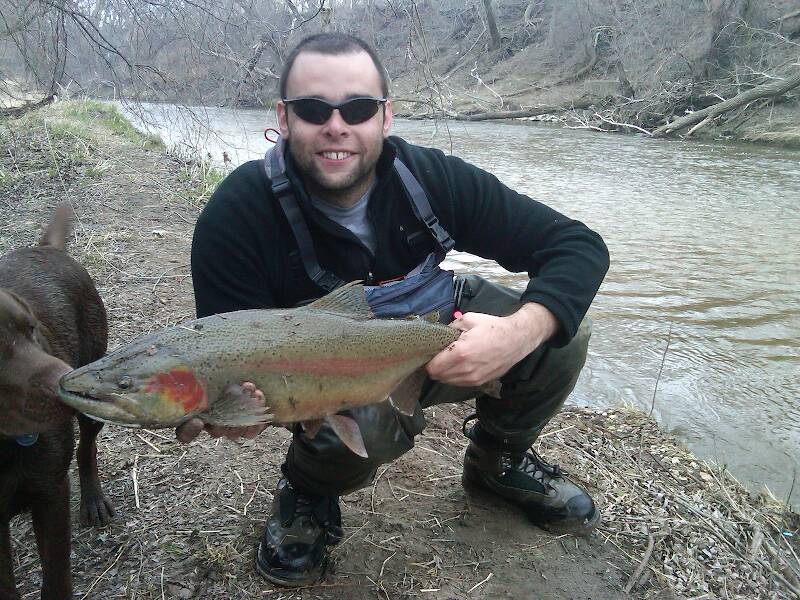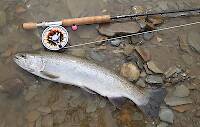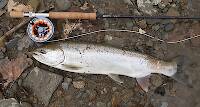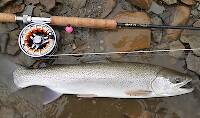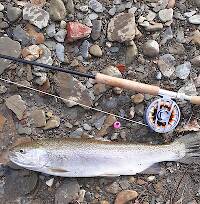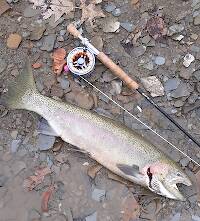
Blue-winged Olives
Baetis
Tiny Baetis mayflies are perhaps the most commonly encountered and imitated by anglers on all American trout streams due to their great abundance, widespread distribution, and trout-friendly emergence habits.
Featured on the forum

This one seems to lead to Couplet 35 of the Key to Genera of Perlodidae Nymphs and the genus Isoperla, but I'm skeptical that's correct based on the general look. I need to get it under the microscope to review several choices in the key, and it'll probably end up a different Perlodidae.

Troutnut is a project started in 2003 by salmonid ecologist Jason "Troutnut" Neuswanger to help anglers and
fly tyers unabashedly embrace the entomological side of the sport. Learn more about Troutnut or
support the project for an enhanced experience here.
GldstrmSam on Jun 25, 2013June 25th, 2013, 1:08 pm EDT
In one of the sloughs I like to fish at there are some nice sized Long-nose Suckers and whitefish. The only problem is that I do not know what to use for either of them. I have heard that nymphs are good for whitefish, but I have still had no luck with them.
You can answer my questions together or separately. It does not matter to me.
Samuel
You can answer my questions together or separately. It does not matter to me.
Samuel
There is no greater fan of fly fishing than the worm. ~Patrick F. McManus
Troutnut on Jun 25, 2013June 25th, 2013, 6:06 pm EDT
I haven't tried catching suckers on flies, but I've managed to catch some whitefish when I could put a nymph right in front of their faces. The key was sight fishing really teasing them with it right under their noses instead of just drifting it past them repeatedly.
Jason Neuswanger, Ph.D.
Troutnut and salmonid ecologist
Troutnut and salmonid ecologist
Jmd123 on Jun 25, 2013June 25th, 2013, 6:51 pm EDT
About three years or so ago I caught a 15" redhorse sucker on a #10 mottled brown/grizzly Woolly Bugger. Looked exactly like a skinny carp, right down to the gold body and red fins! Don't know if this helps but you could try it, though I imagine a proper nymph rolled right under their noses wouldn't be refused...
Jonathon
Jonathon
No matter how big the one you just caught is, there's always a bigger one out there somewhere...
GldstrmSam on Jun 27, 2013June 27th, 2013, 8:09 am EDT
Thanks guys! Both of your posts were helpful. Now to go try it.
There is no greater fan of fly fishing than the worm. ~Patrick F. McManus
Kschaefer3 on Jun 27, 2013June 27th, 2013, 8:36 am EDT
I am assuming the slough is still water, correct? I catch red horse suckers in my trout streams on just about any nymph. Not intentionally, they just sit with the trout. I would look into fishing carp on flats and try to mimic that. It seems to me that this fishing would be very similar. If they are cruising, smaller, buggy streamers in natural colors. Put it 3 ft in front of them, let it sink and hope they grab it. Look at Jon's KBF. Maybe you will switch the name to KSF or KWF :)
Jmd123 on Jun 27, 2013June 27th, 2013, 2:06 pm EDT
Kyle, I did catch a 10-lb. carp once on a chartreuse KBF! He ignored it while I was working it, but once I just let it sink down to the bottom he swam over it and sucked it in. Sadly, he didn't put up much of a fight, and was able to land him on a 7-foot 3-weight (which he should have broken!). He (or she) was 28" long.
Also, redhorse suckers are considered to be intolerant of pollution and indicators of good water quality. No surprise you're catching them right alongside trout!
Jonathon
Also, redhorse suckers are considered to be intolerant of pollution and indicators of good water quality. No surprise you're catching them right alongside trout!
Jonathon
No matter how big the one you just caught is, there's always a bigger one out there somewhere...
Entoman on Jun 28, 2013June 28th, 2013, 1:03 am EDT
Hi Sam,
Whitefish are salmonids and regulated as sportfish. It's unfair to reference them with suckers!:) Though often an annoyance when after trout, they take flies readily which is always a good thing. If it weren't for their plain looks and reputation as poor table fare, they'd have been held in higher esteem. Good sized ones can put up quite a fight.
While it's true they are prone to taking deep nymphs right on their noses (I've caught hundreds that way in the Truckee drainage among many other locations), they will take a moving fly, often in preference to a dead drift presentation. I remember a few years back taking them by the dozens on of all things, a big deeply swinging Wooly Bugger. This occurred in the deep slots of runs in an Eastern OR freestone. The other day I was fishing with John (Cutbow) and took quite a few on a shallow swinging nymph. One even jumped a few times! There was one stretch where they wouldn't leave that nymph alone unless it was dead drifted deep.
There are few axioms in flyfishing.:)
Whitefish are salmonids and regulated as sportfish. It's unfair to reference them with suckers!:) Though often an annoyance when after trout, they take flies readily which is always a good thing. If it weren't for their plain looks and reputation as poor table fare, they'd have been held in higher esteem. Good sized ones can put up quite a fight.
While it's true they are prone to taking deep nymphs right on their noses (I've caught hundreds that way in the Truckee drainage among many other locations), they will take a moving fly, often in preference to a dead drift presentation. I remember a few years back taking them by the dozens on of all things, a big deeply swinging Wooly Bugger. This occurred in the deep slots of runs in an Eastern OR freestone. The other day I was fishing with John (Cutbow) and took quite a few on a shallow swinging nymph. One even jumped a few times! There was one stretch where they wouldn't leave that nymph alone unless it was dead drifted deep.
There are few axioms in flyfishing.:)
"It's not that I find fishing so important, it's just that I find all other endeavors of Man equally unimportant... And not nearly as much fun!" Robert Traver, Anatomy of a Fisherman
Troutnut on Jun 28, 2013June 28th, 2013, 2:55 pm EDT
While it's true they are prone to taking deep nymphs right on their noses (I've caught hundreds that way in the Truckee drainage among many other locations), they will take a moving fly, often in preference to a dead drift presentation.
This advice doesn't conflict with mine... they do seem to like motion and they like things right under their noses. So if you can put it right in front of them and give it a few twitches (or swing it through at the right depth) then you're in good shape.
In my experience, it's very rare for a whitefish to move very far for a fly. I've seen it maybe twice. There are surely plenty of counter-examples from other places and times, but that's been the usual for me in Alaska.
If it weren't for their plain looks and reputation as poor table fare, they'd have been held in higher esteem.
Around here they seem to be pretty well-respected as table fare, because they are delicious. The main fishery for them is spear fishing when they migrate through a local road-accessible area to spawn.
It seems the most common whitefish we encounter while grayling fishing are round whitefish, which aren't as well respected as other varieties, but I think they're okay.
Jason Neuswanger, Ph.D.
Troutnut and salmonid ecologist
Troutnut and salmonid ecologist
GldstrmSam on Jun 28, 2013June 28th, 2013, 9:45 pm EDT
Hi Sam,
Whitefish are salmonids and regulated as sportfish. It's unfair to reference them with suckers!:)
I am very sorry about that misunderstanding. I do truly realize the value of whitefish that is why I brought it up. The reason I brought it up here is because the suckers and the whitefish are the two kinds of fish in the slough that I don't know how to catch.
I know that the two species are totally different in almost all ways.
Thanks for your help.
There is no greater fan of fly fishing than the worm. ~Patrick F. McManus
Quick Reply
Related Discussions
Topic
Replies
Last Reply
Five days of warmwater flyfishing in southeastern Michigan - from Jonathon
In Fishing Reports by Jmd123
In Fishing Reports by Jmd123
0
Jul 22, 2009
by Jmd123
by Jmd123
1
Feb 23, 2009
by Martinlf
by Martinlf
2
Apr 25, 2016
by Afishinado
by Afishinado


